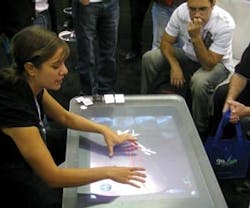The Evolution of Communication Furniture
Solutions for bringing data to workstations are a common necessity for office environments – especially because the scourge of cables can quickly become excessive. The current offerings of integrated panels and wired furniture are flush with variety; however, these solutions are set to become extinct as the habits of business communication evolve. This cycle of replacement is typical – office furniture needs to be updated along with the technology it proffers – but the human proportions of furniture, which are the fundamental elements, do not change. This poses the question: What can be new about a table?
The answer begins with the evolving habits of communication. Since the paperwork explosion of the 1950s, the typical office presumption is that each worker operates primarily from an isolated station, because that’s where documents are stored and correspondence occurs. Today, these habits are rapidly changing – data storage is now virtual, and digital communication is omnipresent. Schools and businesses are finding that productivity is occurring more informally in places like open learning labs. These spaces use furniture that’s functional in a social way, encouraging interaction and exchange. Data cables and wired furniture will soon be a relic of the past as they give way to shared interactive surfaces and pocket computers. Examples of this emergent vision are under way at Microsoft Office Labs, and a sample video, titled "Productivity Future Vision," can be found at www.officelabs.com.
A need for tables to accommodate a computer, a keyboard, a mouse, a monitor, and accessory devices, along with their wiring, will be replaced by furniture elements that are all of these components integrated as a complete entity. Instead of plugging computers into workstations, consumers will instead purchase communication furniture. This future isn’t as far off as it may sound; one groundbreaking product, a touchscreen tabletop, had its recent debut in Sheraton Hotel lobbies. A hotel guest can walk up and instantly have the tools necessary to put together a multimedia presentation.
As the market for the next generation of communication devices matures, it becomes important that office environments manage the transition from today’s heavily wired desktop reality to an informal, wireless reality. Core furniture elements with the ability to satisfy non-virtual functions should be reconsidered; they can give a balance of character to mass-produced interactive stations.
Eric Smith is a designer at MUSA Design (www.musadesign.net) in Seattle.
